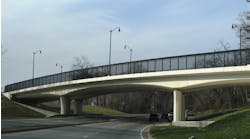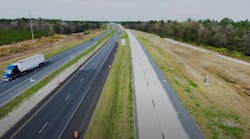Pavement management can be defined as the process of overseeing the maintenance and repair of a network of roadways at or above established values, within budget constraints, while meeting customer expectations.
This process is the means to balance the condition of the network with a specific budget and somehow meet the customers’ expectations of the roadway asset. These three elements are dynamic and should be recognized as such. Changes in any or perhaps all three of these elements could require a pavement program to rework established approaches.
A healthy pavement-management system, or any asset maintenance program for that matter, must be capable of balancing these three primary constraints and not break down. This is especially challenging in these budget-strained times.
Specific to Hillsborough County, Fla., is the following:
Inventory description/ budget
- 6,993 lane-miles
- Rural to major arterials;
- 4 lane-miles of rigid pavement; and
- Essentially zero dirt roads.
- Budget
- FY 2009—$13.9 million
- FY 2010—$7.1 million
- FY 2011—$7.1 million (projected)
- FY 2012—Projected FY 2012 budget could further be reduced by as much as 50% with the elimination of the Community Investment Tax (CIT) as a revenue source for pavement.
- GASB 34 Compliant 2000
- Pavement condition index (PCI) to be maintained above 55 (0-100), BOCC adopted; and
- Adopted ASTM Standard D6433-03—Sept. 17, 2008.
Hillsborough County accomplishes the pavement-management process by employing three basic steps. These are inspection, planning and implementation. This is a basic approach that could be implemented to any size inventory.
These three steps are the basic elements in the development of Hillsborough’s pavement-management program.
Most inspection programs, such as Hillsborough’s, have some basic requirements and goals.
- Inspect all of the roads every three years (GASB 34 requirement);
- Annual report on overall PCI;
- Overall PCI is to be above 55 (Hillsborough); and
- Inspections may require third-party verification.
Truck-counted inspections
Inspection frequencies are established as a matter of becoming GASB-compliant. Hillsborough County inspects approximately one-third of the inventory every year to meet this requirement. Every year a report is generated from the pavement-inspection data, which calculates the overall PCI of the entire system. This is done as length weighted and arithmetic average.
In the past, Hillsborough has used consultants to verify the overall PCI rating. This is not typically done every year. However, in the early years of the program this was needed to add validity to the new procedures that were being put into practice. In some years the auditors required evidence of PCI changes with treatments and evidence that the county was creating procedures that would sustain the integrity of the program. These are now part of the standard information produced for the annual audit and review.
Hillsborough County owns and maintains two pavement inspection vehicles. These trucks are equipped with GIS mapping and an automated data-collection computer system that assists inspectors with defect identification on pavement. The truck also has a GPS navigation system that identifies sample areas on the roadway and automatically selects mapped samples for the inspector. The quantity and severity of the defects are recorded using a touch tablet and software on the trucks’ data-collection computer system. The sample inspection data is then uploaded to the county pavement database (MicroPAVER) for processing.
Hillsborough County began developing a pavement-inspection vehicle in 2006, and today the vehicle can collect as many as 19 visual distresses as measured by an inspector on a particular road. Onboard GIS/GPS-enabled databases with georeferenced photographs are used.
Hillsborough County adopted the ASTM standard 6433-03 (Standard Practice for Roads and Parking Lots Pavement Condition Index Surveys) in 2008. This is a 0-100 scale that can identify 19 pavement-related defects. The inspections are visual and most are measured by a linear or area dimension with the appropriate severity.
MicroPAVER is a data-management/database software package that is available through APWA. MicroPAVER was developed in the 1970s to help the Department of Defense manage its vast inventory of pavements. It continues to be supported by the USACOE and has a user base of over 600 internationally.
Good-first basis
Step two of the Hillsborough pavement-management process is the planning of the project work. Essentially this is nothing more than creating groups of roads based on treatment and fiscal year. A group is a “list” of roads that are planned to be treated within a given fiscal year. The groups are created based on the following considerations:
- Condition;
- Budget; and
- Strategy
Hillsborough’s strategy is quite simple—keep the good roads good. This means abandoning strategies such as worst first or a standard program which would call for treatments at a regular interval regardless of condition. Hillsborough’s pavement strategy embraces the following:
- Worst roads are to be budgeted for and placed in a fiscal year;
- Treatment is based on condition;
- Spatial components are considered. Apply consistent treatments within the same neighborhoods;
- Priority is given to arterials;
- Treatments used must increase PCI; and
- Includes orphan contingency performed by small in-house paving crews.
It is difficult to explain to some residents why roads that are in worse condition are not treated first. The answer lies in the fact that the worst roads are the most expensive to repair. The worst-first approach consumes budget dollars the fastest and produces the lowest lane-mile production. This prevents most of the inventory from receiving any benefit from budget dollars and over time will decrease the PCI of the entire network unless there is sufficient budget to perform a major rehabilitation on virtually all of the roads within the life cycle of the pavement.
Therefore, it makes more fiscal sense to apply a less expensive treatment earlier in the life of the surface that extends the usable life of that surface. Hillsborough accomplishes the planning of the treatments by using a database that has a visual map for the user to select roads for treatment. A GIS also could have been used, however most of the construction professionals wanted a tool that was specific to pavement and did not burden them with cumbersome spatial tools that they did not need. Hillsborough commissioned a computer data window to be constructed which would allow for the selection of roads visually and place them into project groups. This program is called the Roadway Activity Planning Program (RAPP).
The concept is simple enough. The database pulls information already available in the county GIS (road name, length, from street, to street, etc.) and allows the user to place streets into groups that are defined by fiscal years and treatments. Hillsborough currently has over 10 years of historical data and three years of future planned treatment projects. This data can keep track of work-order history that can be uploaded in MicroPAVER for the updating of work history and PCI credits/adjustments based on treatment.
Seeking treatment
Hillsborough County currently uses several treatments to implement the pavement-preservation efforts. These are:
- Crack seal used in conjunction with microsurface, and thin overlays;
- Microsurface—single and double course;
- Micropave—Superpave 4.75 with a 76-22 PM binder;
- Hot in-place repaving (HIR)—single-pass operation with virgin lift overlay;
- Overlay—Superpave mixes;
- Mill and overlay—wedge mill when possible;
- Full-depth reclamation (FDR); and
- Conventional reconstruction.
The usage and performance of these treatments can be tracked and evaluated with the tools from steps 1 and 2. Treatments can be tweaked for optimal performance. The inspection and planning tools allow for treatment performance curves to be created. It is important to understand that performance of a treatment largely depends on the ability to identify which treatments should be applied to correct what kinds of defects and when should that project be executed.
As expected, defects in the MicroPAVER system negatively effect the scoring of a pavement.
Missing the diagnosis for the correction of a defect by utilizing the wrong treatment will most likely be expensive to correct and will undermine the confidence in any pavement-preservation efforts. Getting the correct treatment on the right road at the right time will reap benefits, but misusing treatments to correct defects that they were not designed to address can wreck a program. It is imperative to understand the correct application of any treatment, and the limitations and benefits of that treatment.
To illustrate this point take, for example, an HIR project and an FDR project. Both leave the surface in the same condition when completed, that is, essentially a new surface. However, the defects that are treated by HIR and those corrected by FDR are not the same. A road candidate for HIR is most likely a road that is raveled, has some cracking (longitude or block) and is not deeply rutted. The cracking should be less than 1 in. in depth. In addition, the reveal at the curb should be less than 1 in. The PCI of this road would be somewhere in the 48 range.
On the other hand, the FDR candidate road would most likely have all of the defects of the HIR road candidate but also exhibit some base distresses like deep rutting and alligator cracking. The PCI of this road would probably be in the 29 range.
When properly applied to correct road candidates, both roads would essentially be new roads and therefore life expectancy would be comparable, however, the cost to treat is not the same.
The cost to own the HIR road is therefore less when the cost per square yard is calculated, since the usable life of the road should be equal between the two treatments. Money is saved because the treatment was used to correct the appropriate defects.
Now consider the consequences for using the HIR process on the defects of the FDR candidate road.
Immediately after the HIR project is completed, the road will still have a PCI of 100, however, the deterioration curve for the HIR project will be much steeper than expected. Since HIR does not correct base defects, any deficiencies from the base will reappear in a relatively short time. The road surface will reflect the defects of the base, and the curve will drive back to the 29 range faster than expected.
In the same life span, another treatment would have to be performed to meet customer expectations and PCI goals for the road. Therefore, even though the cost per square yard to perform the HIR may have been initially less, because the treatment was not used properly the cost per square yard per year is actually more due to the rapid deterioration, and the misapplication of the treatment.
Eight and counting
Hillsborough County’s pavement management program is now eight years old. It houses 10 years of historical data and three years of projects planned for the future. In the eight-year history of the program, there have been ongoing adjustments to make improvements as lessons are learned and the performance of treatments is evaluated. This process of continually self-critiquing a program is necessary to maintain a healthy program and system. The pavement program is not viewed as finished because that implies that all the variables that affect the program have become fixed or static. Rather, the program is viewed as dynamic—always exploring change to produce better outcome.


